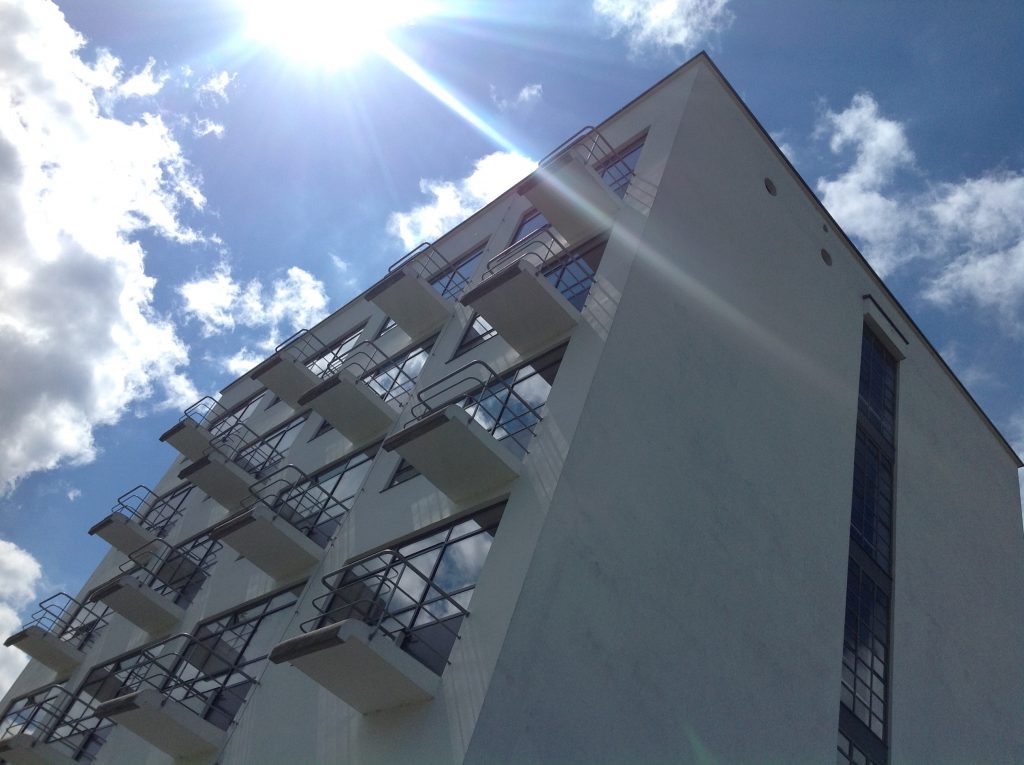An expanded version of this essay, “What I Could Lose: The Fate of Lucia Moholy,” can be read in our Winter 2016 issue.
*
Lucia Moholy did not like living in Dessau. She grew up in Prague, and later moved from the Czech capital to Berlin. The subsequent relocation to this small town, in the northeastern region of Saxony-Anhalt where the Mulde and Elbe rivers meet, could not satisfy her urban inclinations. “dessau is like a place where someone traveling misses their connection and has to wait for the next train. nothing more than a place to wait for the next train. one would do better to never get off in this city in the first place,” she wrote in her diary in early May 1927. Yet a couple years earlier, she had got off the train in Dessau, to live with her husband, the painter, photographer, and typographer László Moholy-Nagy who had been appointed to teach at the Bauhaus—a German school of modernist architecture, art, and design that was born out of the ashes of the First World War and died with the coming of WWII. Together they lived in one of the Master houses, built by the first Bauhaus director Walter Gropius for prominent teachers. Theirs was located directly next to his, house number two (and the only two destroyed in an Allied air raid in 1945).
Today, Dessau is still a sleepy town, less than two hours by train from Berlin. On a sunny Friday afternoon a few weeks ago when I visited the former school, the streets were mostly empty, save for the tourists ambling about, taking photos of the Bauhaus buildings. On the short walk from the campus to the house in which Lucia once lived, down what is now ordained “Gropiusallee” after the first Bauhaus director, there was but a bakery, flower shop, Turkish Imbiss, and a closed art supply store. It was hard for me to imagine the cosmopolitan woman of the Bauhaus living here, yet at the same time, her history is wholly interconnected with this place. Lucia was a great photographer in her own right, and the famous photos of the school buildings, and of László at work in his studio, were taken by her, here.
Later in May 1927, Lucia writes in her journal again, this time addressing László directly: “dear laci–why can you not believe me, that it is the big city that suits me? […] i simply can’t bear it anymore, even though i’ve traveled some in this time […] it’s not the same thing as how one just needs a bit of meat every now and again because he doesn’t only want to eat spinach every day. believe me—i need a change of environment. the goal is not for me to leave you, but rather to find you again.”
In fact, Lucia did not leave Dessau for good that year. But in 1928, when Walter Gropius stepped down as director of the Bauhaus, Lucia and László left the school too, and they were finally able to get on that next train out of Dessau, headed back to Berlin. That year, there is a three word entry in her diary that marks the beginning of this new era for her and the Bauhaus in general: anfang mai: berlin (“beginning of May: Berlin”). But the return to Berlin did not much help her relationship with László. A year later, they separated, and in 1934, officially divorced.
Perhaps Lucia already sensed the inevitable end that spring of 1927. Again addressing László directly in her diary, she writes: “dear laci—you have so much more strength than I do. […] were i as vivacious as you, it wouldn’t all be so necessary. but i can’t manage it, the beautiful side of things here only makes it all the more clear—all the more clear to me, what I could lose.”
There is a deep sense of loss in Dessau, which was heavily bombed in World War II, rebuilt as an industrial town during the Communist period, and looks to be just finishing up the process of building a modern, international post-‘89 façade. The Bauhaus buildings, left to crumble for decades, now shine like new, though true to their present capitalist guise some of the workshop spaces have been replaced with a museum, gift shop, and café. Visiting today, it is hard to conjure what it might have been like to be a student at the Bauhaus during its five short years of operation in Dessau (it was forced under National Socialist pressure to move to Berlin in 1930, and was ultimately shuttered in 1933). But Lucia was everywhere in Dessau for me. I have spent time with her posthumously, reading her diaries and letters kept at the Bauhaus archive, and looking through her photographs, which include a series of nude self-portraits she took in 1930 after she was “liberated” from Dessau, the Bauhaus, and László. I have been the voyeur she never intended to be leafing through her life with white gloved hands. I don’t take this privilege (for which I never asked her permission) lightly. Her story is now folded into me as we walk through the streets of Dessau, where she is a ghost, haunting the place in which she longed for the city.
Lucia Moholy’s diaries are kept at the Bauhaus-Archiv in Berlin, Germany. Image is the author’s.




